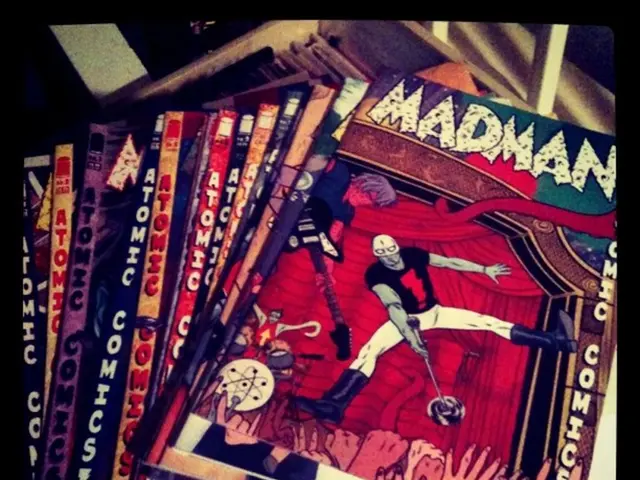Waste Food Transforms into Apparel, Revamping the Fashion World
In 2024, the realm of sustainable fashion has expanded significantly, with food waste transformed into stylish, eco-friendly fabrics. Food waste textiles, the cutting-edge solution to the global food waste issue, are now touted as tomorrow's fashion statements.
One third of all food produced for human consumption is currently wasted each year, amounting to approximately 1.3 billion tons. This alarming figure not only signals a wasted food resource, but also symbolizes the squandered water, energy, and labor that went into its production.
However, the mounting food waste could be repurposed into "food clothes," reducing waste in landfills while simultaneously cutting down on greenhouse gas emissions. Food waste in landfills produces methane, a potent greenhouse gas, making this potential solution all the more significant.
A prime example of this innovation is Piñatex, a leather-like material created from the fibers of pineapple leaves, an agricultural by-product. The process involves collecting the leaves, stripping them into fibers, and processing them into a non-woven mesh, which later forms the base of Piñatex. This sustainable fabric is becoming increasingly popular among fashion brands, such as Po-Zu and VEERAH.
Another example of food waste textiles can be found in the form of Orange Fiber, a fabric produced from the cellulose found in orange peels—a by-product of the juice industry. The cellulose is spun into a silk-like textile, contributing to a reduction in the 700,000 tons of citrus waste generated annually in Italy alone. E.Marinella and Salvatore Ferragamo are two brands that have adopted this eco-friendly fabric.
Opportunities to reduce environmental impact and create new revenue streams are also found in the apple leather industry, which harnesses the leftover apple pomace from juice production. Instead of paying disposal fees, producers can sell this waste to companies like Ashoka Paris, Frida Rome, and Oliver Co London, which transform it into fashionable, sustainable leather.
Along with environmental benefits, the shift towards utilising food waste in textile production could generate over $1 trillion globally by 2025, according to a study by the Ellen MacArthur Foundation, and create millions of jobs within the circular economy.
Herein, we will delve deeper into various sustainable fabrics made from food waste that are redefining the fashion landscape and offering a promising solution to the pressing issue of food waste and sustainability.
The Sustainable Fabrics Made from Food Waste
Piñatex (Pineapple Leaves)
Piñatex, a revolutionary textile created from the fibers of pineapple leaves, has been gaining traction in sustainable fashion and upholstery applications due to its similarity to traditional leather. Its production process requires significantly less water compared to cotton or leather, and it avoids harmful chemicals used in traditional leather tanning.
Orange Fiber (Orange Peels)
Orange Fiber, an eco-friendly textile derived from orange peels, is produced from the cellulose found in the by-product of the juice industry. It boasts a silk-like texture and is ideal for a variety of sustainable fashion applications.
Apple Leather (Apple Skins)
AppleSkin, another sustainable fabric, is produced from the waste of the apple juice industry, with the apple waste being processed and combined with a polyurethane mixture to create a durable and versatile leather-like material.
QMilk (Milk Protein)
QMilk is a sustainable textile made from casein, a protein found in sour milk. Its production is eco-friendly, using minimal water and energy, and resulting fibers are 100% biodegradable.
Fish Leather
Fish leather, a sustainable alternative to traditional leather, is produced from the skins of discarded fish, primarily within the seafood industry. Not only is it durable and flexible, but its unique patterns and scales add a distinctive touch to clothing and accessories.
Coffee Grounds
S.Café, a fabric derived from coffee grounds, is popular in the activewear industry for its quick-drying abilities and odor-controlling properties. This innovative use of coffee grounds helps reduce the 18 million tons of global coffee waste annually.
Banana Fiber
Banana fiber, extracted from banana plant stalks, is a lightweight, breathable, and biodegradable fabric. Its production process requires minimal water and energy.
Mushroom Leather (Mycelium)
Mushroom leather, or mycelium leather, is grown on agricultural waste, making it a rapid and resource-efficient solution for bio-based materials. Brands such as MycoWorks and Bolt Threads utilize this eco-friendly alternative in their leather designs.
Wine Leather
Wine leather, also known as Vegea, is crafted from the by-products of the wine industry, such as grape skins, seeds, and stalks. This sustainable material is soft, flexible, and available in various finishes, appealing to both designers and consumers.
Coconut Fiber (Coir)
Coconut fiber, or coir, offers a textile made from coconut husks, which are typically discarded after the fruit is harvested. This fabric is durable, breathable, and resistant to microbial growth, providing a sustainable alternative to more traditional materials.
A Transformative Shift in Fashion
As the world becomes more aware of the environmental impact of waste production, we can expect to see a surge in food waste textiles. By harnessing agricultural by-products, repurposing food waste, and embracing creativity, sustainable fashion is breaking barriers and paving the way towards a greener planet.
In addition to reducing waste in landfills, these innovative textiles represent an opportunity for entirely new revenue streams and job creation. The cycle of stopping food waste before it reaches landfills, reducing greenhouse gas emissions, and stimulating local economies is proving to be a win-win for the environment and consumers.
Sustainable fabrics derived from food waste will undoubtedly revolutionize the fashion industry, thus redefining fashion's relationship with food waste. With brands like Po-Zu, VEERAH, E.Marinella, Salvatore Ferragamo, Ashoka Paris, Frida Rome, Oliver Co London, QMilk, MycoWorks, Bolt Threads, Vegea, Malai Biomaterials, and Noyoco on board, the future of sustainable fashion looks truly promising.
Konstantina Antoniadou
Konstantina Antoniadou is a sustainability writer with expertise in Chemicals and Health from Johns Hopkins University, focusing on the toxicity of common household chemicals and their health impacts. She has completed specialized studies in Sustainable Fashion (Copenhagen Business School), Business Models for Sustainability, and Sustainable Development Goals (University of Copenhagen), deepening her knowledge of personal choices and global environmental change. With years of experience as a senior writer and researcher, Konstantina now leads our reviews of non-toxic home products, beauty and skincare brands, and sustainable fashion. She is also the creator of the popular 7-Day Non-Toxic Living Challenge.
Enrichment Data:
- Nazeerah (https://www.nazeerah.co/)
- BEDI (http://bedi.se/)
- Rifò (https://rifo design.com/)
- In addition to the burgeoning realm of sustainable fashion, a growing interest in incorporating food waste into 'lifestyle' products, particularly in the 'fashion-and-beauty' and 'home-and-garden' sectors, is being witnessed.
- The rise of food waste textiles not only promises a reduction in waste in landfills but also creates opportunities for expanding the 'business' of eco-friendly products and generating new revenue streams.
- Moreover, these innovative fabrics made from food waste could potentially contribute to the advancement of 'sustainable-living' practices, thereby diminishing greenhouse gas emissions and promoting a more environmentally conscious 'lifestyle'.
- As the fashion industry adopts more sustainable practices, it is expected that an increased focus on 'food' waste utilization in textile production will redefine the industry's relationship with waste, driving 'lifestyle' choices towards a more sustainable future.






